In early June the world of leaf and blade and flowers explodes, and every sunset is different.
John Steinbeck

As we move through the seasons, we are gathering many ideas for our garden and, given that we plan to leave a good deal of the space to nature, there is much inspiration to be found in the wilder places around us. It’s incredible how quickly everything has changed in the last couple of weeks: the air is scented with elderflower, honeysuckle and hay, the verges are bright with oxeye daisies, buttercups and poppies and the hedges above them are embroidered with trails of pink and white wild roses. What a garden that would all make!
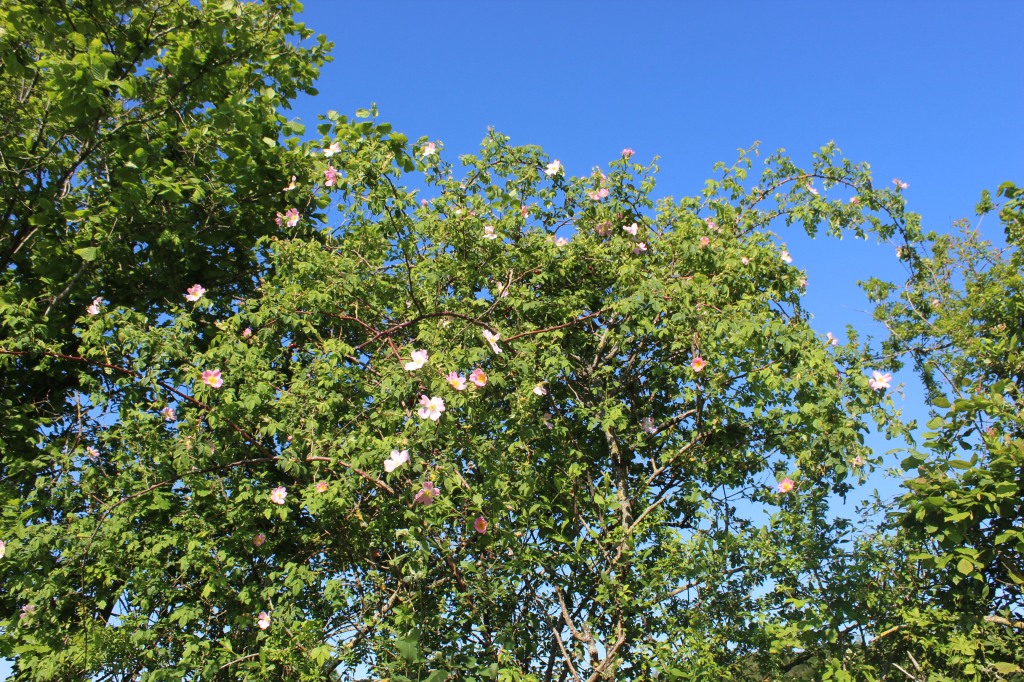

The weather here has shifted from the sublime to the ridiculous: following a colder than normal April and May, the temperatures now are much higher than expected and still climbing – it’s ‘flaming’ June, for sure. As we’re not given to too much exertion once the thermometer climbs above 30 degrees, we decided to grab a bike ride before the high heat arrives and set off with a picnic on a 20-mile loop to St-Léonard-des-Bois. Our route from home took us along lanes through farmland and woodland and gave us some spectacular views of the Mayenne countryside; now that the maize fields have lost the brown of their bare earth, it is all wonderfully, deeply, sumptuously, summery green.

I love the way the mix of flowers in the verges has changed through spring and even now, when the grasses are tall and the carpets of bluebells and orchids have faded, there is still much to enjoy. The deep indigo of granny’s bonnets, white stars of campion, pink bursts of ragged robin and delicate mauve bells of campanula would all be welcome treasures in the garden.


There is no question, though, that poppies are the absolute star of the moment; whether drifting along field edges or in bolder swathes across entire meadows, they are utterly stunning.

As we stopped to admire and photograph one particular field, a friendly chap delivering bread around the hamlets stopped to ask if we were enjoying les coquelicots; we were in complete agreement that the beauty of the sunlit flowers under an intensely blue sky was certainly worth savouring – how could we not stop and stare? I was particularly taken with a planting mix of poppies and white and crimson clover, so pretty together, a good green manure and great for insects; that is definitely one that has been noted for next summer’s garden.


Then, of course, there is that classic cornfield mix of poppies with cornflowers. So gorgeous. Who could resist?

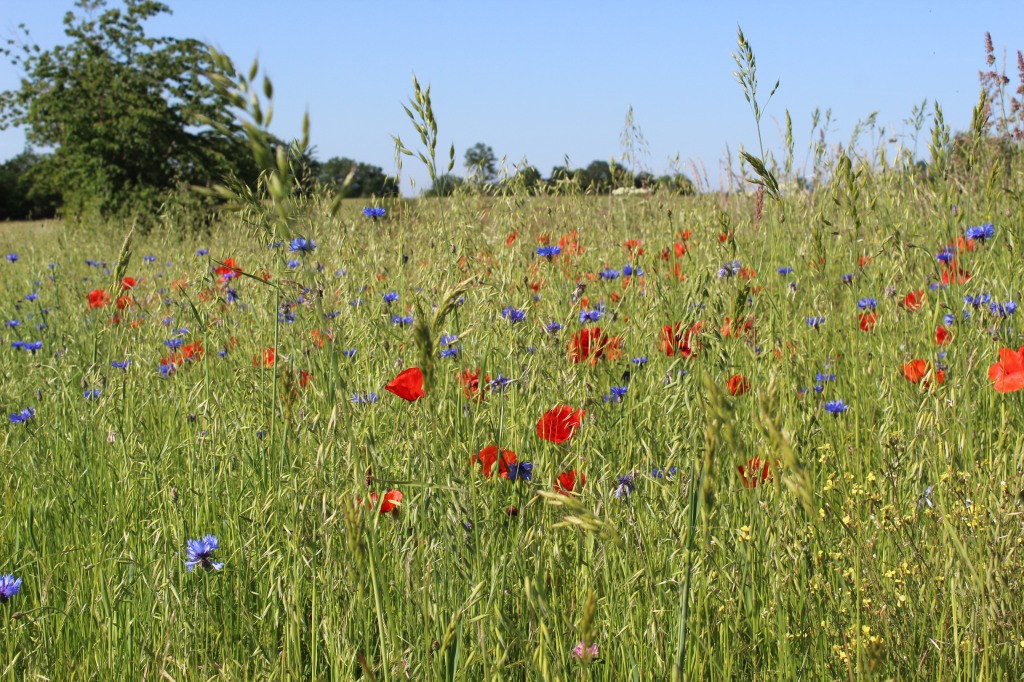
With distractions like these, it’s a wonder I ever arrive anywhere on my bike, but happily we did eventually make it to our destination. St-Léonard-des-Bois is a small town in the Alpes Mancelles, close to St-Céneri-le-Gérei which I wrote about in an earlier post. It’s a pretty place, a classic French ville fleurie on the Sarthe river and an understandably popular spot for holiday makers, but it wasn’t the town we had come for. About a kilometre away, and a steep climb out of the town, is the Domaine du Gasseau. Our first stop was at the pretty orchard picnic site where we sat in the shade of an apple tree and enjoyed our lunch: homemade pasties stuffed with goat’s cheese, walnuts, red sorrel and thyme and a salad of young perpetual spinach, rainbow chard and beetroot leaves, rocket, land cress, radish, mint, marjoram, chives and chive flowers – our first official garden harvest! (We could have taken a pot of strawberries, too, but they don’t tend to travel very happily in a rucksack.) There are several attractions at Gasseau: an attractive stone hotel with pale green shutters and a courtyard cafe, a small art gallery, a riding school and an adventure park where braver souls than me can connect with their inner ape by swinging about in the treetops. For me, though, the main attraction is the potager, open free of charge to the public all year round.

We have been going there for years and it has been fascinating to watch it develop and mature over time. It has always been organic but has now moved very much into the sphere of permaculture so there were plenty of new things to see, including a couple of mandala beds. I have to admit I did feel slightly ashamed at the state of our garden in comparison to this beauty, but then it is a walled garden in a sheltered spot so probably hasn’t had to cope with the same winds and heavy frosts and certainly, that lush soil has been built over decades. No wonder it is already so full of food, colour and life. I could easily spend a whole day there, wandering about, looking and musing; there are so many ideas, so much inspiration – where do I start? Perhaps with more poppies . . .






One of the main issues our visit to the potager really brought home to us was the need to feed our soil. We are trying to create a garden from possibly the worst starting point, grassland – formerly a field – that has been mowed with a heavy tractor for the last thirteen years; the soil is compacted, full of wireworm and chafer grubs and very, very tired. The lack of goodness in the soil is reflected in the unenthusiastic growth of much of what we have planted and who can blame the plants? No-one thrives on a poor diet, after all. It would be easy to feel frustrated and pessimistic but it’s not all bad news; the soil is deep and stone free, there is a lot we can do to improve it and some things are trying their best, despite everything.

So, although we are still creating and extending planting spaces, the focus this week has been very much on building and improving soil. First, Roger repurposed pallets and sheets of corrugated iron to build a three-bay compost system. The third bay is currently taken up with a turf walled enclosure filled with a mix of green and brown materials; once it has broken down into compost, we will move it and finish building the last bay. In the other two bays, we turned a broken blackthorn bough into a chopped base layer and then covered it in grass clippings. The first bay has become our new compost heap with materials added daily from the kitchen, the second one kept me busy for a while . . .
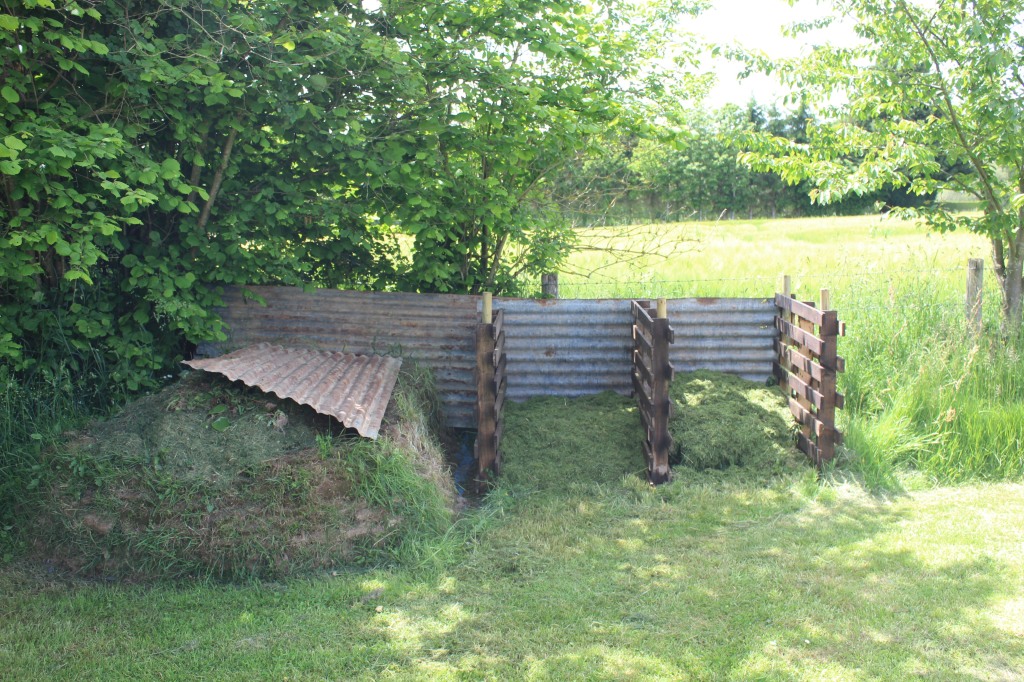
. . . time to shift the old compost heap out of the Secret Garden at last! I can’t say how happy I am to see the back of those ugly concrete slabs and rusted metal poles but to fair, the system has yielded a decent amount of black stuff; I love that whole cross-section thing, the layers becoming darker, crumblier and more and more deliciously composty from top to bottom. I’ve inverted most of the heap into the second bay and that will be left untouched now to complete the wonderful alchemy (sorry, I do get a bit excited around the whole compost thing); the very bottom layer was used to fill the black bin where the worms will carry on with their good work until we put that beautiful stuff to use.

Once cleared, I realised what I had left was probably the most fertile patch of land in the entire garden . . . mmm, now there was an opportunity not to be missed. Yes, it’s also very shady but there are plants that will go a long way to tolerating that so I transplanted a few rainbow chard and lettuce into the space; at least they won’t be short of nutrition.


When it comes to nourishing the soil, I know what it really needs is a good deep layer of well-rotted manure but we don’t have a ready supply of that at the moment and anyway, autumn is the best time to apply it so that the weather and worms can work it down over winter. Remembering Mary Reynold’s advice that anything organic coming from a patch of land should be returned to it and the goal within permaculture to strive for as many closed loops as possible, the leading question must be what have we already got that we can use? I was really thrilled that my bottles of comfrey tea and two more good roots to plant were on the load Roger brought back from Asturias last week; for me, it’s the most important plant in the garden and although the single root I brought here in December is romping away, it isn’t enough for this year. We do have an abundance of nettles, though, and so I’ve set a bucket of them to brew into a nutrient-rich tea that when diluted, will make an excellent plant food. Meanwhile – in a bit of a lightbulb moment – it occurred to us that we have a ready supply of wonderful rich soil packed with organic matter in the coppice.
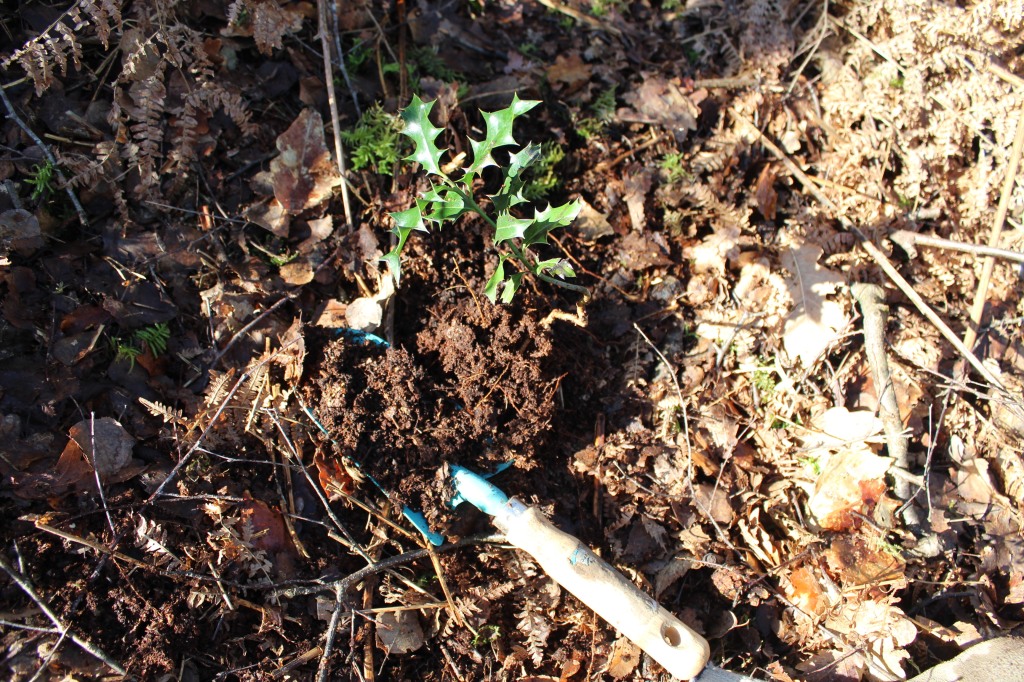
An hour with a spade and couple of buckets yielded a decent trailer load lifted carefully from deep pockets of woodland floor soil with the minimal disturbance – we have pledged to care for and protect the coppice, after all! Not only is it fantastically rich but also abundant in the microscopic life we can’t see, the mycelium and bacteria that should be hugely beneficial to the garden. One day, I hope all our soil looks that dark.

The terrible spring weather wreaked some havoc in the garden, particularly where the beans were concerned; it was simply too cold and too wet, perfect conditions for bean seed flies to do their worst (and they did) and dismal for plants already struggling in poor soil. The climbing beans (borlotti and Asturian) were so badly hammered that as soon as the tunnel was up, I planted replacements in a very crammed tray and what a difference – within three days they were up, as green and healthy as you like! I fed the bean circle soil with an organic fertiliser, replanted with a dollop of our compost in the bottom of each hole, watered well and mulched. The weather is now perfect for them, the soil beneath their roots much healthier, their companion plants (calendula, coriander dill and cucumbers) filling out and they are off up their poles at long last. Phew, that’s better.

The dwarf beans have been a similar nightmare, with a row of ‘Purple Teepee’ and handful of ‘Stanley’ desperately struggling to survive, although they have pulled through better than the climbers. What has really frustrated us is the row we have sown twice now with no sign of a single bean . . . literally, digging down it seems they all completely disappeared. I’ve come to the conclusion that trench warfare is the only way forward with planting for the rest of this summer and starting beans in trays is the best practice to adopt. I dug out the bean trench and lined the bottom with shredded comfrey leaves and a dollop of compost; that will be topped with grass clippings and soil so that when I transplant the plants currently racing up in their trays, they will have plenty underneath them and – fingers crossed – with regular doses of comfrey and nettle tea, this time they might even grow!

We’ve taken this idea a step forward in creating a lasagne bed for the ‘Green Globe’artichokes I’ve raised from seed, half a dozen plants which are perennial and therefore will be in the ground for many years. The concept of lasagne beds is one that was illustrated in theory and practice at the Gasseau potager so, fully inspired, we decided to have a go.

First down was a layer of cardboard. The plants have had enough of their pots and I’d like to get them planted soon rather than first build the bed over several months, so Roger marked spaces with them using inverted plant pots.

Next, a layer of the long meadow grass cut from the strip behind the bed to allow the artichokes some growing room.

Then came a woody layer from the compost heap, one that had been created by the oak leaves I collected and added to the pile some months ago.

This is just the beginning; I shall plant the artichokes, then continue to build green and brown layers around them. Not quite the orthodox approach, but with luck it will result in a bed of rich soil and perhaps a first harvest this time next year. I hope our little garden companion approves!
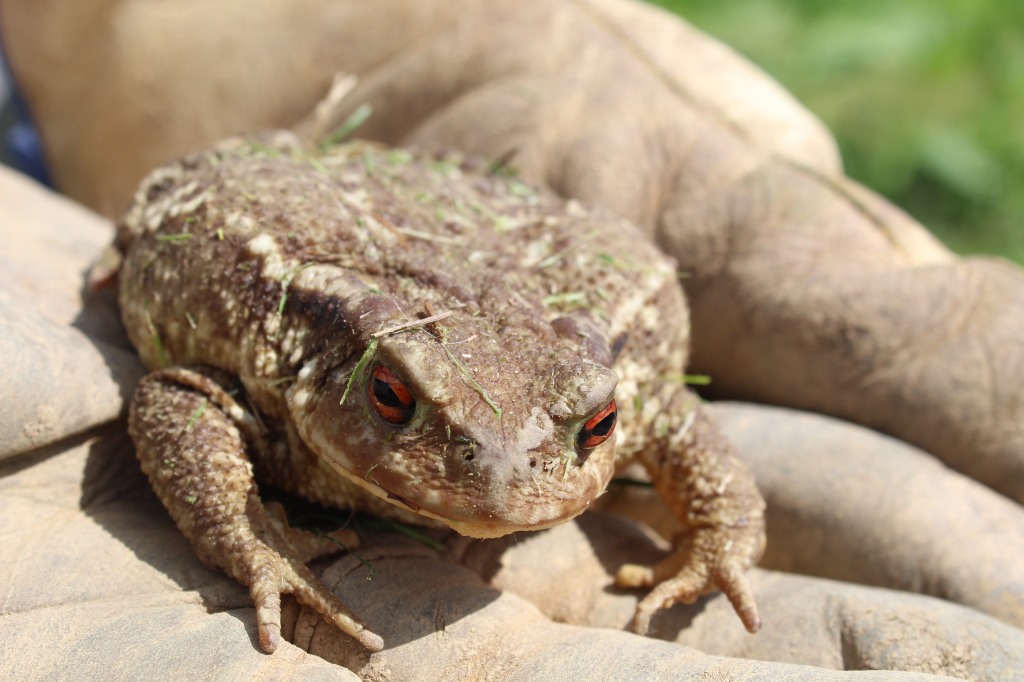
Back to that bike ride, and the last hill took us past our coppice, now in full leaf, ringing with birdsong and lit with the creamy lace of elder flowers. We returned the next day to pick enough heads to make a cordial; it’s a simple process (I use this recipe from River Cottage) and makes a light, refreshing drink that surely must be the very taste of the season.

We are working hard to build soil and heal the land, to create a patch that is healthy, vital and productive but I realise that will take time; however, it’s good to know that even if we lack produce from the garden, we can still forage for wild food and enjoy with gratitude the bounty that nature has to offer. This surely must be one of the very best ways of connecting with the earth and celebrating this most beautiful of seasons. Flaming June is blessing us with flowers. How lovely is that? 😊


What an absolutely glorious part of the world you’re in! Your pictures are just delicious!
Hopefully the soil will improve quickly for you ❤ I have everything crossed for speedy land-healing!
LikeLiked by 2 people
It is really beautuful, I’d forgotten just how lovely, to be honest. The wild flowers have been breathtaking for weeks. Thank you, fingers crossed here, too – I need to exercise a little patience (not always my strong point), keep working away at it and trust nature to do the rest. 😊
LikeLike
Thank you for sharing this, Lís!
Your bike journey reminded me of a quote from one of my very favourite books, The Third Policenan:
“‘Michael Gilhaney,’ said the Sergeant, ‘is nearly sixty years of age by plain computation and if he is itself, he has spent no less than thirty-five years riding his bicycle over the rocky roadsteads and up and down the hills and into the deep ditches when the road goes astray in the strain of the winter. He is always going to a particular destination or other on his bicycle at every hour of the day or coming back from there at every other hour. If it wasn’t that his bicycle was stolen every Monday he would be sure to be more than half-way now.’ ‘Half-way to where?’ ‘Half-way to being a bicycle himself,’ said the Sergeant
LikeLiked by 2 people
That made me smile, Pádraig! I know you do a lot of cycling, hope the weather and wildflowers are being as kind as they are here. 😊
LikeLiked by 1 person
Again, I’m a teeny bit envious (just a bit!) of all the places you have within your reach, or at least the reach of your bike tyres. What a lovely place to visit. And how hard the two of you are working on your gardens. I’m sure dramatic results will continue to occur.
The photos of the poppy fields are simply splendid.
LikeLiked by 3 people
I must admit after the mountains in Asturias, it is a treat to be able to enjoy cycling excursions without too many hills to struggle up! Field poppies have always been one of my favourite flowers and they are truly stunning at the moment, particularly backlit by the sunlight. The garden will come, I just need to be more patient, I think!
LikeLiked by 1 person
Your photos have evoked wonderful memories of our visits to France.
Your garden sounds a bit like ours, when we arrived, but we were faced with massive amounts of wood chips that had been layered so thick that the soil was starved! We continue to work on it, and are greatly rewarded when a new area is brought back to life so that it can be planted up again.
I am looking forward to reading your future posts.
LikeLiked by 2 people
Thank you and welcome! Good soil certainly takes time to build but is worth the effort and I share that joy of seeing a patch come back to life. What I really need is a bit more patience! 😉
LikeLiked by 1 person
So beautiful!! I love the photos and that flowers are a part of permaculture design! We have similar flowers where we live, no butterfups tho! 🧚🏻♀️🌻🌼
LikeLiked by 2 people
Thank you, Chloe, and welcome! I think I’ve reached a point where I love the mix of vegetables, flowers and herbs (plus wild things) more than anything else – the days of separate planting schemes are over! 😊
LikeLike
Well done to you both!
LikeLiked by 2 people